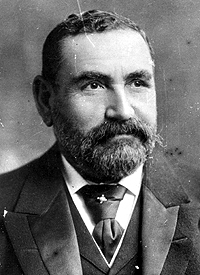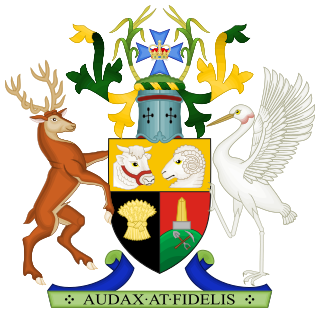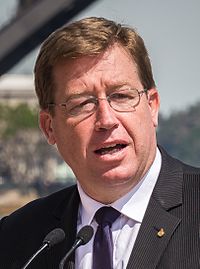
The New South Wales Department of Justice was a state government agency in New South Wales, Australia, that operated under various names between 2009 and 2019. In 2019, most of its functions were absorbed by a new Department of Communities and Justice. The department was responsible for the state's justice system – courts, prosecutions, prisons, sheriffs – and most emergency service agencies.

Bradley Ronald "Brad" Hazzard is a retired Australian politician who served as the member of the New South Wales Legislative Assembly district of Wakehurst between May 1991 and March 2023.

The Minister for the Arts is a Minister of the Crown in the New South Wales Government who has responsibilities for the administration and support for the arts in the state of New South Wales, Australia. The portfolio was abolished in 2019 and merged into the portfolio of Minister for the Public Service and Employee Relations, Aboriginal Affairs, and the Arts; and reinstated in December 2021.

The New South Wales Minister for Education and Early Learning is a minister in the New South Wales Government and has responsibilities that includes all schools and institutes of higher education in New South Wales, Australia.

The Minister for Jobs and Tourism is a minister in the Government of New South Wales with responsibilities for tourism in the state of New South Wales, Australia. It has often been combined with other portfolio responsibilities, most commonly Sport.

The Attorney General of New South Wales, in formal contexts also Attorney-General or Attorney General for New South Wales and usually known simply as the Attorney General, is a minister in the Government of New South Wales who has responsibility for the administration of justice in New South Wales, Australia. In addition, the attorney general is one of the Law Officers of the Crown. Along with the subordinate Solicitor General, Crown Advocate, and Crown Solicitor, the attorney general serves as the chief legal and constitutional adviser of the Crown and Government of New South Wales.

The third Parkes ministry was the nineteenth ministry of the Colony of New South Wales, and was led by Sir Henry Parkes in a coalition with Sir John Robertson. It was the third of five occasions that Parkes was Leader of the Government.

The See ministry was the 30th ministry of the New South Wales Government, and was led by the 14th Premier, Sir John See. The title of Premier was widely used to refer to the Leader of Government, but was not a formal position in the government until 1920. Instead the Premier was appointed to another portfolio, usually Colonial Secretary.

The New South Wales Minister for Corrections is a minister of the Government of New South Wales who is commissioned with responsibility for the administration of correctional services, juvenile justice, and prisons in the state of New South Wales, Australia.

The Minister for Industrial Relations is a Minister of the Crown in the Government of New South Wales who has responsibilities for matters relating to industrial and labour laws and regulation in the state of New South Wales, Australia. The portfolio was established in 1895 in the Reid ministry and titled Minister for Labour and Industry, held in conjunction with the Minister of Public Instruction. The minister is responsible for assisting the Premier and the Treasurer in the administration of their respective clusters.

Solicitor General for New South Wales, known informally as the Solicitor General, is one of the Law Officers of the Crown, and the deputy of the Attorney General. They can exercise the powers of the Attorney General in the Attorney General's absence. The Solicitor General acts alongside the Crown Advocate, and Crown Solicitor, and serves as one of the legal and constitutional advisers of the Crown and its government in the Australian state of New South Wales.

The Minister for Industry and Trade is a minister in the Government of New South Wales who has responsibilities for sponsoring and supporting enterprise, trade, and international investment in the state of New South Wales, Australia. The minister is responsible for administering the portfolio through the Enterprise, Investment and Trade cluster.

The Minister for Lands and Property, also called the Secretary for Lands was responsible for one of the key issues for the colonial administration of New South Wales, being the contest between squatters and selectors to dispossess the Aboriginal people of their land.

The Department of Justice and Attorney-General (DJAG) is a department of the Queensland Government with responsibilities for the administration of justice, support to Queensland courts, regulatory policy and consumer protection, legal aid, youth justice, corrective services, and other community and legal services.

The New South Wales Minister for Homes is a minister in the New South Wales Government with responsibility for the administration and development of social housing and housing policy in New South Wales, Australia.

The Minister for Ports was a ministry first established in 1975 in the Coalition Lewis–Cutler ministry and abolished in 2011. It has had three incarnations and was renamed as the Minister for Ports and Waterways in the First Iemma ministry in 2005. In 2011 the portfolio was merged with that of Roads to form the portfolio of Roads and Ports.

The New South Wales Minister for Hospitality and Racing is a minister in the Government of New South Wales with responsibilities for the oversight of hospitality and for racing in the state of New South Wales, Australia.

The Minister for Small Business is a minister of the New South Wales Government within The Treasury and has responsibilities for matters relating to small business policy and regulation in New South Wales. The current Minister for Small Business, since 31 July 2022, is Victor Dominello.

The Minister for Women is a minister in the New South Wales Government with responsibility for women's issues in New South Wales, Australia.

The New South Wales Minister for Emergency Services is a minister within the Government of New South Wales who has the oversight of the emergency service agencies.









